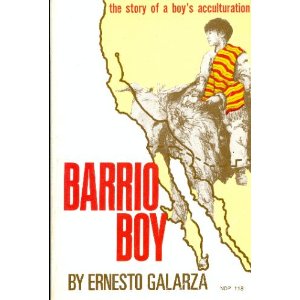Book Review: “Barrio Boy” By Ernesto Galarza
 Reviewed by Luis R. Torres, Latinopia
Reviewed by Luis R. Torres, Latinopia
A Second Look at a Classic of Chicano Literature
Some weeks back Jesús Treviño, the captain of the Latinopia ship, and I agreed to re-examine some of the classics of Chicano literature. This new look at the seminal book by Ernesto Galarza continues that effort. “Barrio Boy” is a masterpiece of autobiography and memoir and its deceptively simple, crystalline prose and its keen historical observations still resonate for Chicanos as well as non-Chicanos interested in learning something about “us” – our history and our frame of reference.
It was a delight to read it again all these years later. “Barrio Boy” was first published in 1971 when Galarza was well into his sixties and after decades as an indisputably accomplished renaissance man who had made indelible marks as a political activist, historian and scholar. It is still a pleasure to read this book and it has a lot to tell us about the general arc of Mexican/Chicano history that is personified by Galarza’s own narrative journey.
The memoir is told through the prism of a child who, we quickly discover, is exceedingly bright, inquisitive and remarkably observant. It describes his journey from a tiny village in the state of Nayarit to the barrio of Sacramento, California. His family, like thousands of others in Mexico, was forced to flee the chaos and dislocation caused by the Mexican Revolution of 1910. Galarza was born in Jalcocotán in 1905.
The book is the engaging story of his personal journey. His arrival in the United States sets the stage for a child’s perceptions of the strangeness of the language, customs and social dynamics of this country. Because of his individual strength and fortitude, Galarza accommodates to this new world with relative ease and he quickly begins to thrive, starting in elementary school. El era muy vivo. The story is told in the voice of a boy discovering and beginning to make sense of the world around him.
In a preface to “Barrio Boy” Galarza explains that the book is based on anecdotes he had long told his family and friends about growing up, essentially transforming himself from a mexicano to what we would now call a modern day Chicano. Fiercely proud of his heritage, he nonetheless absorbs the culture and ethos this strange world called the United States. It is an odd world, but one filled with stimulating challenge and opportunity. For years Galarza had been encouraged to write down those recollections. He sat down to do it for what he calls “historical” reasons. But he also emphasizes something quite important, and that is, that he wanted the book to dismiss the sociological balderdash that was heard so often in the 1950s and 1960s – that somehow Mexicans who came here, or their progeny, had somehow lost their “identity.” Nonsense, he says.
With razor sharp simplicity he writes: “Psychologists, psychiatrists, social anthropologists and other manner of ‘shrinks’ have spread the rumor that these Mexican immigrants and their offspring have lost their ‘self-image.’ By this, of course, they mean that a Mexican doesn’t know what he is; and if by chance he is something, it isn’t any good. I, for one Mexican, never had any doubts on this score. I can’t remember a time when I didn’t know who I was. Those I knew and remember and tell about had an abundance of self-image and never doubted that it was a good one.” Punto.
Today, as Chicanos, we may be a distillation of two worlds, two cultures, but we are whole human beings. Galarza never had any doubts about that.
In “Barrio Boy” we see, even at a very early age, the evolution of Galarza’s frame of reference regarding fairness, justice and the struggle of the “outsider.” He keenly observes the dynamics of labor in the ranchos of Nayarit. He saw how peones were sometimes treated as chattel and not as human beings. He writes: “For me the world began to divide itself into two kinds of people – the men on horseback and the men who walked.” Many years later, as he began to organize farmworkers in California in the 1950s, he was keenly aware of the oppression that workers faced at the hands of the agribusiness owners and callous labor contractors, the “men on horseback.”
Galarza thrived as a teenager in Sacramento, leaving the barrio for higher education. He received degrees from Occidental College in Los Angeles, Stanford University and Columbia University. His doctoral dissertation at Columbia was about industrialization in Latin America. That led to work at the organization that was the precursor to the Organization of American States. He returned to California in the 1950s where he began the difficult task of organizing farmworkers, laying the foundation for the valuable work that Cesar Chavez and Dolores Huerta were to do, beginning in the 1960s. His intimate work among farmworkers led to his most acclaimed book, “Merchants of Labor” which exposed the abuses of the infamous bracero guest-worker program. He eventually went on to a career as an acclaimed writer and much admired scholar.
The work “pioneer” is often used too freely today. But there is no hyperbole in stating emphatically that Ernesto Galarza was a genuine pioneer in many fields. “Barrio Boy” gives us the window into Galarza’s early life and how he drew on those experiences as a man on a quest to enlighten society about the historical roots and cultural frame of reference of today’s Chicanos. We can learn a great deal about ourselves and our place in history by reading “Barrio Boy.” We should be grateful to Galarza for his work and for taking the time to put down the string of anecdotes that comprise this wonderful little memoir.
This article first appeared in Latinopia.
Luis Torres, a journalist and writer from Pasadena, California, is at work on a book that examines the 1968 East Los Angeles high school student walkouts.
[Photo courtesy Amazon]
